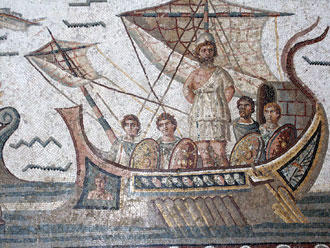The Werewolf of Temesa January 25, 2011
Author: Beach Combing | in : Ancient , trackbackA painfully short post tonight but Tiny Miss B is screaming next to the keyboard, Mrs B is out looking for a school for the elder daughter and Little Miss B is making the au pair’s life an inferno downstairs. So in dereliction of parental duty another part of the soon-to-end werewolf series: let’s hope that the social workers don’t find out.
Pausanias, Greek antiquarian – antiquarian sounds so much better than historian doesn’t it? – records the legend of Euthymus of Locri and a woolly Hero.
Odysseus, so they say, in his wanderings after the capture of Troy was carried down by gales to various cities of Italy and Sicily, and among them he came with his ships to Temesa [in Magna Grecia, Italy]. Here one of his sailors got drunk and violated a maiden, for which offence he was stoned to death by the natives. Now Odysseus, it is said, cared nothing about his loss and sailed away. But the ghost of the stoned man never ceased killing without distinction the people of Temesa, attacking both old and young, until, when the inhabitants had resolved to flee from Italy for good, the Pythian priestess forbade them to leave Temesa, and ordered them to propitiate the Hero, setting him a sanctuary apart and building a temple, and to give him every year as wife the fairest maiden in Temesa. So they performed the commands of the god and suffered no more terrors from the ghost. But Euthymus happened to come to Temesa just at the time when the ghost was being propitiated in the usual way; learning what was going on he had a strong desire to enter the temple, and not only to enter it but also to look at the maiden. When he saw her he first felt pity and afterwards love for her. The girl swore to marry him if he saved her, and so Euthymus with his armour on awaited the onslaught of the ghost. He won the fight, and the Hero was driven out of the land and disappeared, sinking into the depth of the sea. Euthymus had a distinguished wedding, and the inhabitants were freed from the ghost for ever.
So where’s the wolf? Well, nowhere to be seen in the legend that Pausanias hands down to us. But it seems likely that originally (or in one early version of the legend) the Hero was lupine because of a picture that Pausanias reports having seen.
This I heard, and I also saw by chance a picture dealing with the subject. It was a copy of an ancient picture. There were a stripling, Sybaris, a river, Calabrus, and a spring, Lyca. Besides, there were a hero-shrine and the city of Temesa, and in the midst was the ghost that Euthymus cast out. Horribly black in color, and exceedingly dreadful in all his appearance, he had a wolf’s skin thrown round him as a garment. The letters on the picture gave his name as Lycas.
Was Lycas then a werewolf? Or are we perhaps dealing with an outcast, common in legends across Euro-Asia, the young man who goes out into the wilderness and ‘wolfs’ around stealing and destroying.
Then there is also the problem of the antiquity of this image. The picture that Pausanias saw was a copy of an ‘ancient’ picture: are we talking then of a century or six or seven centuries?
Beachcombing is hungry for more Greek or Roman werewolf references: drbeachcombing AT yahoo DOT com



